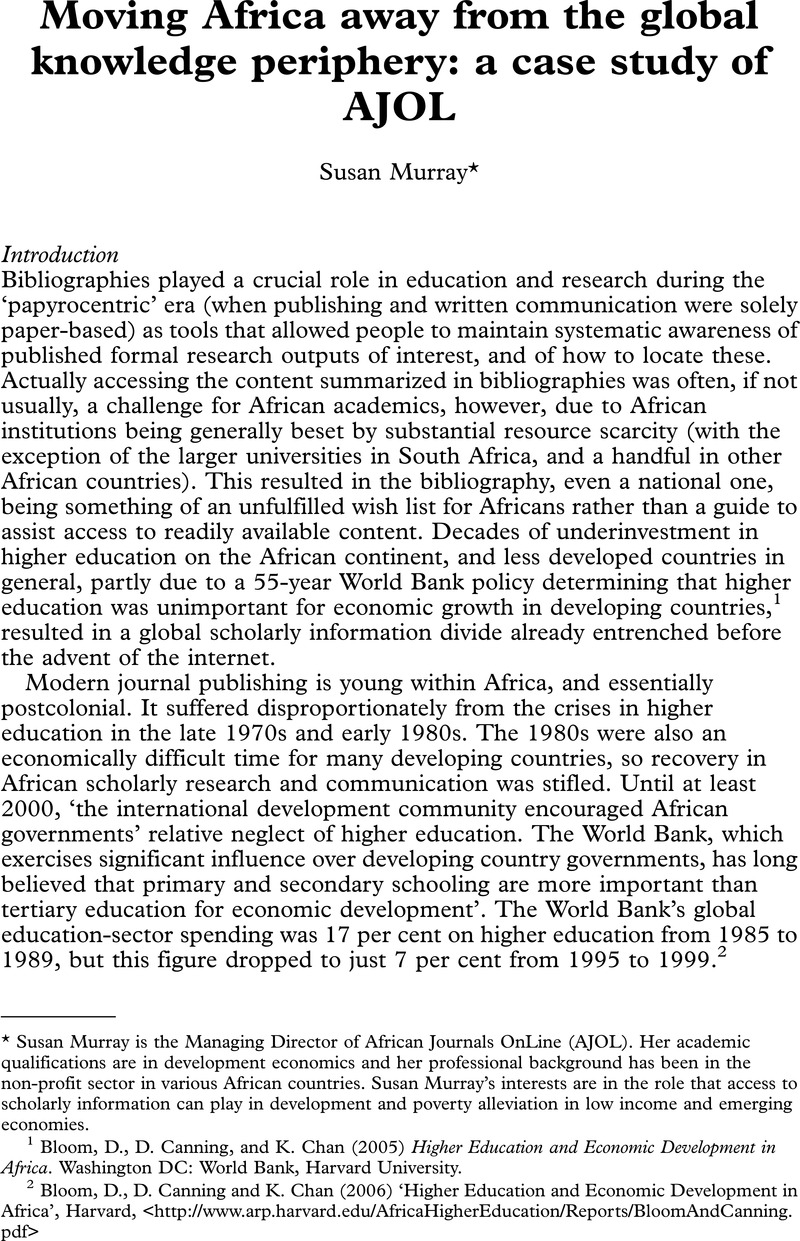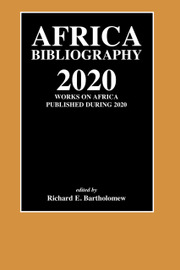Article contents
Moving Africa away from the global knowledge periphery: a case study of AJOL
Published online by Cambridge University Press: 17 April 2013
Abstract

Information
- Type
- Introduction
- Information
- Africa Bibliography , Volume 2008: Africa Bibliography 2008 Works on Africa Published During 2008 , November 2009 , pp. vii - xxiv
- Copyright
- Copyright © International African Institute 2009
References
1 Bloom, D., Canning, D., and Chan, K. (2005) Higher Education and Economic Development in Africa. Washington DC: World Bank, Harvard University.Google Scholar
2 Bloom, D., Canning, D. and Chan, K. (2006) ‘Higher Education and Economic Development in Africa’, Harvard, <http://www.arp.harvard.edu/AfricaHigherEducation/Reports/BloomAndCanning.pdf>>Google Scholar
3 Teferra, D. and Altbach, P.G. (2004) ‘African higher education: Challenges for the 21st century’, Higher Education 47: 21–50.CrossRefGoogle Scholar
4 Bloom, D. et al., (2005).
5 Altbach, P.G. (2003) ‘African Higher Education and the World’, in Teferra, D. and Altbach, P.G. (eds), African Higher Education: an international reference handbook. Bloomington: Indiana University Press.Google Scholar
6 Otlet, P. (1934) Traité de documentation. Le livre sur le livre: théorie et pratique (1989, preprint). Liége: Centre de Lecture publique de la Communauté française.Google Scholar
7 Guédon, J.C. (1994) ‘Why are Electronic Publications Difficult to Classify?’, Directory of Electronic Journals, Newsletters and Academic Discussion Lists, Association of Research Libraries, <http:dlist.sire.arizona.edu/335/01/guedon.html>, accessed 5 August 2009.Google Scholar
13 Alemna, A.A., Chifwepa, V. and D. Rosenberg (1999) ‘African Journals: an evaluation of the use made of African-published journals in African universities’, Education Research 36, London: Department for International Development.Google Scholar
14 Nwagwu, W. (2005), ‘Deficits in the Visibility of African Scientists: implications for developing information and communication technology (ICT) capacity’, World Review of Science, Technology and Sustainable Development 2 (3 & 4): 244–60.CrossRefGoogle Scholar
15 Cetto, A. M. (2001) ‘The Contribution of Electronic Communication to Science – has it lived up to its promise?’, Proceedings of the ‘Second ICSU-UNESCO International Conference on Electronic Publishing in Science held in association with CODATA, IFLA, and ICSTI and UNESCO House’, Paris, 20-23 February.Google Scholar
16 Kotecha, P. (ed.) (2008) Towards a Common Future: higher education in the SADC region. Research findings from four SARUA studies. Southern African Regional Universities (SARUA) Studies Series, <www.sarua.org>Google Scholar
17 Lor, P.J. and Britz, J.J. (2005) ‘Knowledge Production from an African Perspective: international information flows and intellectual property’, International Information and Library Review 37 (2): 61–76.Google Scholar
18 African Union Commission (2008) The African Regional Action Plan on the Knowledge Economy (ARAPKE) Flagship Projects (Phase One) p. 5.Google Scholar
19 Kotecha, P. (ed.) (2008).Google Scholar
20 The British Academy and the Association of Commonwealth Universities (2009) ‘The Nairobi Report: frameworks for Africa-UK research collaboration in the social sciences and humanities’, March.Google Scholar
21 <http://www.internetworldstats.com/stats1.htm#africa>, accessed 1 August 2008.,+accessed+1+August+2008.>Google Scholar
22 Appfrica.net Webpage (2008) ‘Google Backs Launch of 16 Satellites to bring 3bn Online’, <http://appfrica.net/blog/archives/434>>Google Scholar
23 Lor, P.J. and Britz, J.J. (2005) ‘Knowledge Production from an African Perspective: international information flows and intellectual property’, International Information and Library Review 37 (2): 61–76.Google Scholar
24 Smart, P. (2005) ‘African Journals Online (AJOL)’, Serials Review 31 (4).CrossRefGoogle Scholar
27 <http://pkp.sfu.ca/>
28 Lagoze, C. (2004) ‘Bridging the Past and Future: scholarly communication in the 21st century’, Russian Digital Libraries Journal 7 (3): 88–96, <http://www.cs.cornell.edu/lagoze/papers/Tsukuba%202004.pdf>Google Scholar
29 Jaygbay, J. (1998) ‘The Politics of and Prospects for African scholarly Journals in the Information Age’, in Knowledge Dissemination in Africa: the role of scholarly journals. Chestnut Hill, MA: Bellagio, p63–74.Google Scholar
30 Zeleza, P.T. (1997) Manufacturing African Studies and Crisis. Dakar: CODESRIA.Google Scholar
31 Zell, H.M. (1999) A Handbook of Good Practice in Journal Publishing,2nd Edition. London and Oxford: International African Institute and African Books Collective.Google Scholar
32 Jaygbay, J. (1997) ‘African Scholarly Journals, Slow Decline or Quantum Jump?’, LOGOS 8 (2): 85–9.Google Scholar
33 Adbowale, S. A. (2001) ‘The Scholarly Journal in the Production and Dissemination of Knowledge on Africa: exploring some issues for the future’, African Sociological Review 5 (1): 1–16, <http://www.codesria.org/Links/Publications/contents_asr/asr_5_1.htm>Google Scholar
34 Stellenbosch University Website (2007) ‘Research pages - South African accredited journals’, <http://sun025.sun.ac.za/portal/page/portal/Administrative_Divisions/Navorsing/Research%20Home/Accredited%20Journals/SAJournals2007.pdf>>Google Scholar
35 Mambo, B. (2003) ‘Digital Libraries in Africa: a review of developments since 1996’, in Beebe, M., Kouakou, K.M., Oyelaran-Oyeyinka, B., Rao, M.. (eds), Africa-dot-Edu: IT opportunities and higher education in Africa. New Delhi: Tata McGraw-Hill Publishing Company Limited.Google Scholar
36 Saint, W. (2003) ‘Tertiary Distance Education and Technology in Sub-Saharan Africa’, in Teferra, D. and Altbach, P.G. (eds), African Higher Education: an international reference handbook. Bloomington: Indiana University Press.Google Scholar
37 Proud, L. and Murray, S. (2009) ‘African-published Scholarly Journals: open journal systems and alternative publishing models as used by African Journals OnLine’, in Ngobeni, S. (ed.) Scholarly Publishing in Africa: opportunities and impediments. Pretoria: Africa Institute of South Africa.Google Scholar
38 Smart P. (2005).
40 Teferra, D (2003) ‘Scientific Communication and Research in African Universities: challenges and opportunities in the twenty-first century’, in Teferra, D and Altbach, P.G. (eds), African Higher Education: an international reference handbook. Bloomington: Indiana University Press.Google Scholar
41 Evans, J.A. & Reimer, J. (2009) ‘Open Access and Global Participation in Science’, Science 323: 1025.CrossRefGoogle Scholar
42 ‘The Impact Factor, often abbreviated IF, is a measure reflecting the average number of citations to articles published in science and social science journals. It is frequently used as a proxy for the relative importance of a journal within its field, with journals with higher impact factors deemed to be more important than those with lower ones. The impact factor was devised by Eugene Garfield, the founder of the Institute for Scientific Information (ISI), now part of Thomson Reuters.’ (From http://en.wikipedia.org/wiki/Impact_factor)
43 The term ‘serials crisis’ has become common shorthand to describe the systemic phenomenon of rapidly increasing institutional and library subscription costs of scholarly journals while library budgets have remained static or even decreased. This has resulted in many cases of library cancellations of some subscriptions to maintain others in the face of price increases, thus reducing overall access to research content.
44 Nwagwu, W. E. (2006) ‘Organising and Monitoring Research Production and Performance in Africa: towards Africa citation index’, <http://www.codesria.org/Links/conferences/electronic_publishing06/papers/Williams_Nwagwu.pdf>>Google Scholar
- 3
- Cited by

